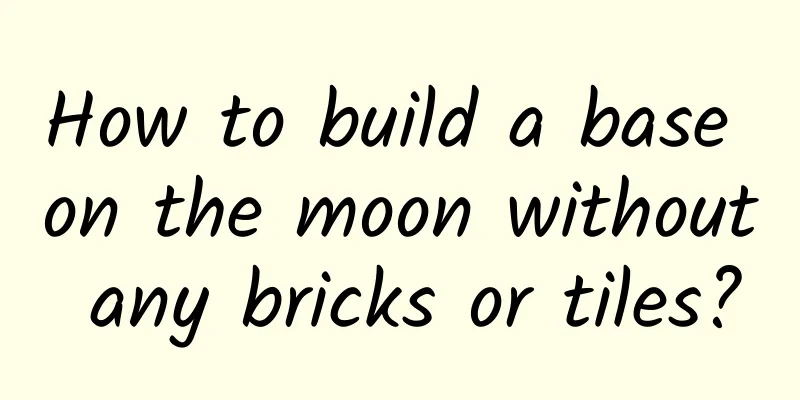How to build a base on the moon without any bricks or tiles?

|
On September 3rd local time, the National Aeronautics and Space Administration (NASA) announced that it would postpone the launch of the next-generation moon rocket "Space Launch System" again. Some analysts pointed out that the US lunar exploration plan is currently facing many difficulties. However, in the future, human enthusiasm for lunar exploration is expected to rise even more. On July 21, 1969, American astronaut Armstrong left the first human footprint on the moon. Now, more than 50 years have passed, but humans have not returned to the moon. The reason is naturally not conspiracy theories, but that the Americans did not think about what to do next at the time. The moon landing cost 0.57% of the US GDP, which is $130 billion in 2021. People must consider what they get for spending so much money. Apparently, NASA failed to convince their Congress on this issue. Scientists even bypassed the moon and hyped up the idea of emigrating to Mars. But humans didn't leave a single brick or tile on the moon, let alone the distant Mars. So, what is there on the moon that is worth the huge investment? **Energy is the first reason. **There is no dust or water vapor on the moon, and the photoelectric conversion efficiency is extremely high. The solar energy received by the moon each year is equivalent to 25,000 times the annual energy consumption of humans. **There are also "perpetual daylight zones" on the moon. **Due to the relationship between rotation and revolution, sunlight always shines on certain places in the polar regions of the moon, where solar power generation can be carried out around the clock. This is an energy source that can be used immediately with existing technology. Helium-3 is the energy of the future. It does not produce neutrons when undergoing thermonuclear reactions and is considered the best controlled nuclear fusion propellant. Helium-3 is very rare on Earth, and humans have only produced 0.5 tons so far. The moon is a huge mine of helium-3, and the scientific community estimates its reserves range from 1 million tons to millions of tons. The world's annual energy consumption is only equivalent to a few tons of helium-3. Want to build a lunar base? The moon itself has construction materials that can be obtained locally, that is, lunar soil. Lunar soil is the dust formed after millions of years of lunar rock fragmentation, or the splash after the impact of small celestial bodies. Lunar soil is almost everywhere on the lunar surface, with a thickness ranging from a few centimeters to several meters. In 1969, there was no equipment that could use lunar soil. But today, there is: 3D printers. **Lunar soil is a high-quality 3D printing material, and today's 3D printing technology can already build small houses on the ground. **So, the first step for humans to build a lunar base is not for astronauts to bring heavy building materials there to assemble, but to launch a large 3D printer to the lunar surface, prefabricate a space for human habitation and work through remote control, and then send astronauts to guard it for a long time. **The lunar surface is almost a vacuum, and astronauts have to endure high-energy cosmic ray radiation there, but the lunar soil itself can provide protection. **Therefore, human bases will not be built on the lunar surface like in "Alone on the Moon", but will be dug down in places where the lunar soil is thicker, so that the lunar soil on top will become a shielding layer. The moon has distinct day and night, and it is hot and cold, but the thermal conductivity of lunar soil is very low. Below 1 meter is a constant temperature layer, where the temperature is kept at around -20℃ for a long time, which is equivalent to a cold storage on Earth, but it can be withstood as long as there is a heat preservation device. **The thermal conductivity of lunar rock is 1,000 times that of lunar soil, and it is easy to be heated by the sun and release heat. **If a regular-shaped lunar rock plate is laid above the base, the sun heats it to more than 100℃ during the day, and then it is lowered into the ground by a mechanical device to release heat, an energy system can be formed. The lunar soil contains silicon dioxide and aluminum oxide, both of which meet the requirements of ordinary construction ceramics. It can be processed into blocks by microwave sintering and can also be used to make glass fibers, all of which do not require the consumption of precious water. Glass fibers are also the raw materials for 3D printing. In the future, there may be many work and daily necessities on the moon, and even building materials themselves will use glass fibers. There are a lot of oxides in the lunar soil. A US company has used heat-collecting optical fibers to conduct experiments and was able to extract 9.6% of the oxygen in the lunar soil. There is even "bound water" in the lunar soil and lunar rocks, which can be released after a little heating. What? All these projects require electricity? As mentioned earlier, the lunar power supply will be sufficient. Even metal materials do not need to be provided by the earth. **Since its formation, the moon has been hit by countless asteroids, some of which are metallic asteroids. After the impact, these metals were buried under the impact point. **There is no geological movement on the moon, so even after hundreds of millions or even billions of years, they will remain in place. If you carefully survey the craters, you can find metals underneath, and you can use them by simply melting them. In the past, humans did not dare to develop the moon on a large scale, one of the important reasons being that all supplies had to be transported from Earth. Now it seems that we only need to invest in various small devices that can be remotely controlled to obtain energy, water, oxygen and building materials from the lunar surface. **This project is called "in-situ development", and the goal is to replace ground supplies with local resources,** taking root in situ, rather than sending lunar resources back to Earth. Yes, in addition to helium-3, scientists have only found 5 substances in lunar samples that are not found on Earth, and their value is not high. The goal of developing the moon is to establish a base outside the earth, not to transport large quantities of products back to Earth. If you change your thinking in this way, you will find that there is indeed a lot to be done on the moon. Source: Popular Science Times Author: Zheng Jun Editor: Wu Tong Review: Wang Fei Final judge: Chen Lei |
<<: Here is a new discovery!!!
>>: Animal ugliness contest, let's see whose "ugly" thing this is...
Recommend
Building a solar system on your living room ceiling? The secret of this ancient planetarium is in the attic
The picture shows the solar system pendulum model...
11 economic phenomena necessary for planning and promotion
Introduction: Starting from the essence and findi...
Ibuprofen "has different effects depending on posture"? The truth is...
Ibuprofen became popular, and the medicine box be...
8 strategies to make your content marketing explode!
When I think of promoting content online, I imagi...
Optimizing the paid experience is the key to Android TV games
In 2014, as relevant state departments relaxed re...
Get APP competitive product analysis report
This article mainly analyzes the knowledge paymen...
Take every step carefully and build a user growth system from scratch!
Recently, I have received a lot of inquiries abou...
Autumn is here, today is the Cold Dew Festival
Today, we usher in the fifth solar term of autumn...
China Automobile Dealers Association: Dealers' used car business scale and profits grew rapidly in 2021
2021 is a difficult year for my country's aut...
"I'm the director!" A woman was forced by her parents to take the civil service exam for five years and suffered from schizophrenia. Please don't control your children in the name of love!
Many parents hope that their sons will become suc...
From 2019 to 2020, these 4 marketing trends will not change
2019 has finally come to an end. This year the ma...
Official account: The Course on the Monetary Emotion Cycle of Speculative Capital
Course Description This course focuses on explain...
Kunshan Social Insurance Fund Management Center: National Internet Security Management Service Platform!
In order to protect network information security,...
"Spring cover-up" is not just about wearing more clothes! If you cover these parts well, diseases will not come to you.
As the saying goes, "cover up in spring and ...
Ten Thousand Leagues Under the Sea
For reprinting, business cooperation, please scan...









